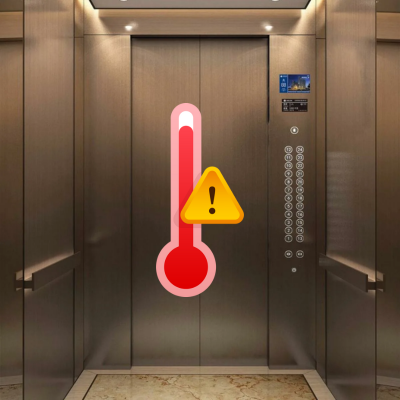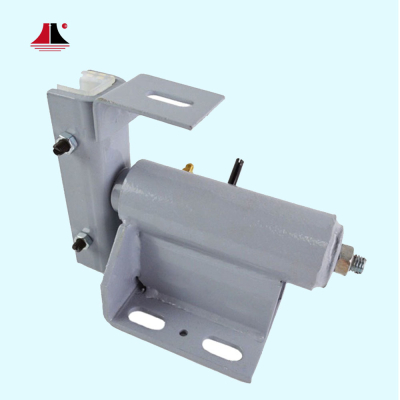Why Summer Heat Fails Elevators?
Elevators work hard every day, quietly and reliably moving people and goods through buildings. But just like people, elevators don’t perform well in extreme heat. In fact, rising temperatures—especially in the machine room—can lead to sudden malfunctions, shutdowns, and costly damage. If you’ve ever experienced an elevator unexpectedly stopping on a hot day, chances are it was feeling the heat too.
In this article, we’ll explain in simple terms why elevators are vulnerable to high temperatures, what parts are most affected, and how we can prevent heat-related failures—especially during summer. Even if you’ve never thought about how an elevator works, don’t worry. We’ll break it all down. And by the end, you’ll understand why proper cooling and maintenance are essential—and why choosing a reliable brand like FUJITA makes all the difference.
Why Elevator Machine Rooms Get So Hot
1. The Building’s Structure Makes It Worse
Most elevator machine rooms are built at the top of the building, often as a separate room on the roof. These rooms are surrounded by external walls and roofs, which absorb a lot of heat from the sun, especially during summer. As outside temperatures rise, these walls heat up and transfer that heat inside, turning the machine room into an oven. The more surface area a room has exposed to direct sunlight, the worse the problem gets.
2. The Elevator System Itself Produces Heat
Elevator components generate a surprising amount of heat during normal operation. The main heat-producing parts in the machine room are:
a. The Inverter (also called the Variable Frequency Drive)
This component controls the elevator motor and frequently switches on and off during operation. These rapid electrical switches generate a lot of heat, especially from components called IGBTs (Insulated-Gate Bipolar Transistors). The more the elevator is used, the more heat the inverter produces.
b. The Braking Resistor
When the elevator moves—especially when going up with little to no load—the counterweight is heavier than the car. This causes the motor to generate electricity instead of using it. That energy needs to go somewhere, so it’s dumped into a braking resistor, which releases it as heat. In many systems, braking resistors can account for nearly one-third of the total energy consumed by the elevator, and all of that becomes heat in the machine room.
c. The Motor
The motor consumes electricity and naturally heats up, especially during frequent starts and stops. The more current it uses, the hotter it gets.
How High Temperatures Damage Elevators
When the machine room gets too hot, it affects both electronic and mechanical parts of the elevator. Here's what happens:
1. Electronic Failures and Control Issues
a. Control Board Malfunctions
Elevator control systems use microprocessors and logic circuits. These are sensitive to temperature changes. If the machine room overheats, these components can start to behave unpredictably. That can cause the elevator to stop suddenly, skip floors, or fail to open or close its doors properly.
b. Inverter Damage
Inverters are very sensitive to temperature. Studies show that every 10°C increase in ambient temperature can cut an inverter’s lifespan in half. Overheating can cause short circuits inside the inverter, permanently damaging it and stopping the elevator.
c. Braking Resistor Overload
Braking resistors can fail or even catch fire if they don’t cool down properly between elevator runs. In a hot room, they never get the chance to cool off.
d. General Component Aging
Other parts like relays, contactors, and transformers all generate some heat during operation. In high-temperature environments, their ability to dissipate that heat is reduced. That leads to premature aging, loss of reliability, and eventual failure. In fact, every 2°C rise in component temperature can reduce reliability by 10%.
2. Mechanical Stress and Breakdown
a. Motor Damage
The motor needs to stay cool to function properly. If the room temperature is already high, the heat generated by the motor has nowhere to go. Even if the motor has built-in cooling fans or thermal protection, persistent overheating can burn out the motor windings, leading to shutdowns and expensive repairs.
b. Gearbox Wear
Most elevator systems use a gearbox with worm gears and bronze wheels. These metals expand at different rates when exposed to heat. As the temperature rises, the precision fit between the parts is lost. That increases friction, accelerates wear, and can cause strange noises or even vibration during elevator movement.
High temperatures also degrade the gearbox oil, reducing its ability to lubricate. This creates more wear and further increases the heat—starting a dangerous cycle that can eventually lead to gearbox failure.
What Can We Do to Keep Machine Rooms Cool?
1. Improve Insulation
Proper thermal insulation in the machine room helps reduce heat transfer from the outside. Too often, machine rooms are treated like utility spaces and left without adequate wall or roof insulation. We should treat them like any other room that houses sensitive equipment.
2. Install Cooling and Ventilation Systems
In hot climates or during summer, passive ventilation is often not enough. Installing exhaust fans, air vents, or even an air conditioning system can help maintain a safe operating temperature.
If using fans, make sure they are placed opposite ventilation openings (like louvered windows) to create proper airflow. When properly designed, this setup can significantly lower the room temperature.
Conclusion
Elevators may seem tough and mechanical, but in reality, they’re complex systems sensitive to their environment. When the machine room overheats—especially in summer—it can affect everything from electronics to motors to the comfort and safety of passengers.
We hope this article has helped you understand how heat affects elevators and what you can do to protect them. Whether you’re a building owner, facility manager, or someone simply curious about elevator safety, taking steps to prevent overheating is a smart move.
Ready to learn more about elevators that are built to last—even in the heat? Discover FUJITA's full range of innovative and reliable solutions. Let’s build smarter, safer, and cooler together.




